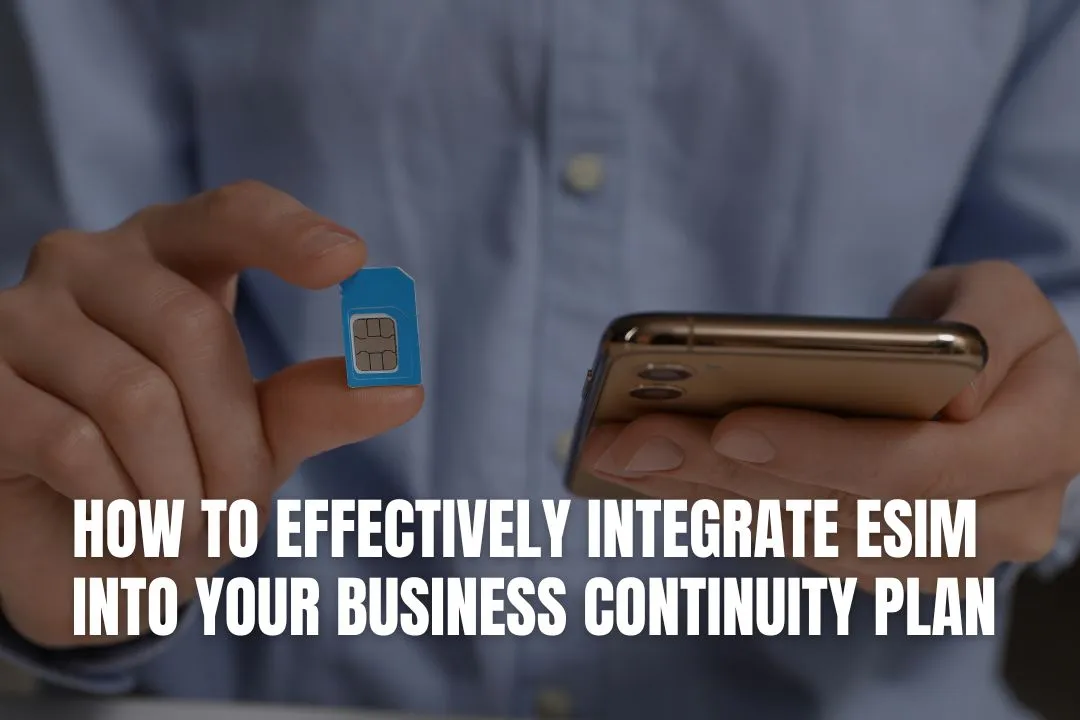
Connectivity is the backbone for running a business in today's digital-first environment. A company's ability to stay online directly affects its resilience, from cloud-based collaboration to remote work and IoT devices. This is the reason why eSIMs ( Embedded SIMs) are becoming a key component of modern business continuity planning (BCP), as they ensure that communication and connectivity remain robust even during disruptions.
This article discusses the steps businesses can take to integrate eSIM effectively into their continuity strategy. So read on!
With traditional SIM cards, your company's connectivity depends on physical logistics, such as installing, updating, or moving SIM cards between offices or regions. This can become a significant problem during emergencies when remote workers or field devices need to stay connected quickly.
This is no longer necessary with online eSIM for travel, as it allows businesses to activate, manage, or change mobile carrier profiles over the air (OTA), so a physical card is not required. This flexibility ensures that your personnel and equipment can remain connected almost immediately through other carriers when there is a network problem or crisis.
You might start by figuring out how your business operations depend on mobile networks and then looking at the threats they pose to your present connectivity. Find out if your staff only use one carrier or numerous providers, look for any single points of failure in your communication systems, and figure out how soon you could get back online after a carrier outage or disaster.
By finding these weaknesses, you can see where eSIM technology can add important backup and flexibility. For instance, a logistics company that uses eSIMs to switch to a backup network automatically when a major carrier fails in a certain area shows how eSIM technology may provide important redundancy and flexibility.

Before you begin, ensure that the tools your team uses daily are prepared for the change. The first step is to confirm that the eSIM is compatible with your device. Most new smartphones, tablets, and connected devices from leading manufacturers like Apple, Samsung, and Lenovo already support this technology, which will ease the transition for many organisations.
Once you have confirmed your devices are compatible, the next step is to select a provider you can trust to help you achieve uninterrupted service. Choose a carrier or global eSIM service with strong coverage across all your main networks, a user-friendly dashboard for managing all your connections in one place, and the capability to activate service from anywhere at any time. Ultimately, you want a provider that not only keeps you connected but also prioritises security to protect your data.
eSIM provides valuable flexibility, but it also requires IT teams to have full visibility over device provisioning, carrier usage, and security. To maintain control, it is important to use a central administration platform for activations, implement rigorous access controls to prevent unauthorised profile downloads, and train employees on emergency procedures.
Additionally, essential eSIM security features such as remote wipe and strong encryption should be incorporated into overall data protection and compliance plans to safeguard the mobile ecosystem.
Since eSIM technology allows a single device to store multiple carrier profiles, the technology exemplifies the fundamental concept of redundancy essential to the continuity of business operations. This provides an inherent safety net. During a power outage, employee phones can instantly switch to a backup network. Additionally, field sensors or Internet of Things devices can maintain their online presence across international borders by seamlessly connecting to the best available local network.
By incorporating this intelligent redundancy directly into your mobile ecosystem, you enable remote teams to continue operations without interruptions caused by replacing physical SIM cards. This proactive approach not only significantly reduces downtime but also ensures that your most important communication channels remain open and accessible under all circumstances.
You should test eSIM integration regularly, just like you would any other part of your business continuity plan. Have your staff practice switching networks or turning on backup connectivity profiles in fake outage situations.
Regular assessments help ensure that your eSIM strategy stays in line with the expansion of your business, new devices, and changing carrier technologies.
As organisations rely more on mobile and IoT connections, having a strong network connection becomes necessary for survival. Adding eSIM to your business continuity strategy is more than just a tech upgrade; it's a step toward being more flexible, reliable, and cost-effective.
The primary benefit is flexibility. eSIMs allow you to switch mobile carriers over the air without needing to physically change a SIM card. This means your team and devices can instantly connect to a backup network during an outage, significantly reducing downtime.
Yes, most modern smartphones, tablets, and IoT devices from major manufacturers like Apple, Samsung, and Lenovo support eSIMs. However, you should always verify compatibility for your specific device models before creating your integration plan.
You should use a central administration platform, often provided by your eSIM service. A good platform, like those offered by specialists such as Robinwaite, allows your IT team to activate, manage, and monitor all device connections and carrier profiles from a single dashboard.
Absolutely. With an eSIM, a device can hold profiles for multiple carriers, including international ones. This allows remote workers or IoT devices to seamlessly connect to the best available local network without needing to swap physical SIM cards, ensuring consistent connectivity across borders.
You should test your eSIM integration as part of your regular business continuity plan reviews. Running drills at least twice a year, or whenever you introduce new devices or change carriers, helps ensure the system works as expected and that your employees are prepared.